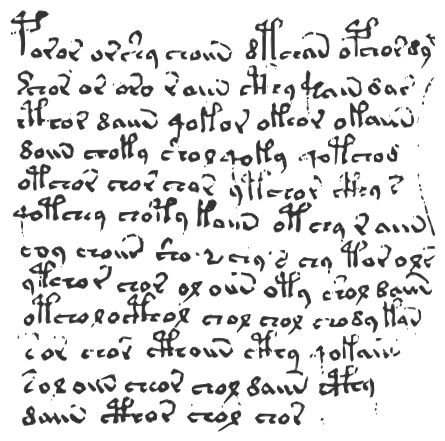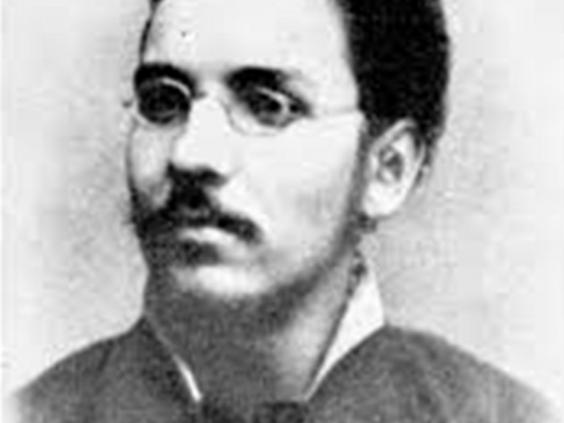
Voynich manuscript excerpt (via Wikipedia)
It is astonishing how ideas often appear in our awareness in curious juxtapositions. While working doggedly and hopelessly on fathoming the mystery of Stonehenge, my mind was sidetracked by an article on The Voynich Manuscript – an enigmatic medieval volume whose script has never been decoded. Like Stonehenge, the notorious manuscript has fascinated and eluded the finest minds for centuries. Written in a language not known to humans, containing images of fantastical plants not to be found on the earth as well as a plethora of baffling astronomical and astrological images, it richly feeds imagination but laughs at the face of reason. There have been theories about the alien origin of the manuscript. Terence McKenna referred to it as “an object from another dimension.” It has been quite firmly established that it was written in a language rather than a code. This explains why the most renowned cryptographers have had no success with it. If it is indeed written in a natural language, the manuscript is the only available written record of it in the whole world. The National Security Agency has published a volume devoted to numerous futile attempts on cracking its code, preceded by an inspiring quote from Roger Bacon: “Reasoning draws a conclusion and makes us grant the conclusion, but does not make the conclusion certain, nor does it remove doubt so that the mind may rest on the intuition of truth, unless the mind discovers it by the path of experience… Therefore reasoning does not suffice, but experience does.” It is curious how the manuscript speaks to us as if beyond the rational mind could ever grasp. We experience its magnificence in the same way as we are captivated by the ca 7000- year-old circle of stones on the Salisbury Plain.
The manuscript can be viewed in its entirety on the website of Yale University (http://beinecke.library.yale.edu/collections/highlights/voynich-manuscript) as well as on its Wikipedia page. Eamon Duffy wrote an interesting article on it for the current issue of The New York Review of Books. I appreciated the author’s fascination with the flamboyant Polish-Lithuanian bookdealer, who discovered the manuscript. If books have personalities, then the quirky manuscript could not have chosen a more original persona as its name-giver. Wilfrid Michael Voynich (known as Wojnicz before he anglicized his name) was born in a noble family and given stellar education in Krakow, Poland. He acquired several doctorate degrees and vast knowledge of several languages. As a plotting revolutionary, he was arrested by Russian authorities and sent to Siberia, from which he managed to escape on a forged passport. He travelled through Mongolia, China, Germany, finally reaching England utterly destitute, having even sold coat and glasses to pay for the passage. It came to pass that in England he utterly reinvented himself into a rogue and brilliantly successful “buyer and seller of rare books.” He managed to acquire numerous books which were coveted by the British Library itself. Among his clients were the most prestigious collectors and institutions, not only the Bristish Library but also the British Museum. He owned a few prestigious shops in London and later in the USA, where he settled.

Last year in January, a Spanish company Siloe bought the rights to make 898 official replicas of the manuscript, which has been locked in the vaults of Yale University since 1969. It was supposed to take 18 months to make the first facsimiles. Will the multiplication of the volume increase the chances of fathoming its mystery? Will the replicas capture a fraction of the original’s mysterious aura? Juan Jose Garcia, director of Silos, said in an interview that “touching the Voynich is an experience. It’s a book that has such an aura of mystery that when you see it for the first time it fills you with an emotion that is very hard to describe.” Rather than focus on an intellectual solution to the riddle of the manuscript, perhaps we should “try to love the questions themselves as if they were locked rooms or books written in a very foreign language,” as Rilke wrote in Letters to a Young Poet.
Links:
http://www.nybooks.com/articles/2017/04/20/voynich-manuscript-secret-knowledge-or-hoax/
http://www.historyfiles.co.uk/FeaturesEurope/EasternPoland_Voynich01.htm
http://www.history.com/news/exact-replicas-of-the-mysterious-voynich-manuscript-to-be-published















All your posts are engaging, but there is something particularly eerie and alluring about this one. This manuscript. Think about what it takes to develop a written language and then write a biology-social-science book in that tongue, complete with illustrations. Who did that? I am intrigued beyond expression!
But then, what if they found JRR Tolkien’s manuscripts written in Elvish, the language he developed for LOTR? If there were no other references, what would we make of it? Could the Voynich be the ‘Silmarillion’ of a lost work of fiction?
Thank you for bringing this to our attention.
I will be wondering about it forever.
🙂
LikeLiked by 4 people
Tolkien is a great example, though his language was not encrypted. Is this because I have Mercury retrograde that I rejoice in unanswered or unanswerable questions. There is nothing better.
LikeLiked by 1 person
It is the sleuth in you, and yes, maybe the Mercury Rx. Curiosity reigns!
LikeLiked by 2 people
spooky cool! and certainly an addictive and awe-inspiring conundrum. gosh, i would love to be able to afford a copy when it comes out. thank you for sharing this.
LikeLiked by 1 person
I adore such cosmic jokes as well. Thank you for commenting.
LikeLike
A very interesting enigma !
LikeLiked by 2 people
Mind boggling:)
LikeLiked by 1 person
Pingback: Living the Question: the Voynich Manuscript – lampmagician
There may be a connection to John Dee with the Voynich mss. Sir Thomas Browne writing of Dee’s alchemical exploits to Ashmole in 1674 – ‘ this transmutation was made by a powder they had, which was found in some old place, and a book lying by it containing nothing but hieroglyphics; which book his father bestowed much time upon, but I could not hear that he could make it out. ‘ Didn’t Athanasius Kircher also have a look at the Voynich in the 1660’s in Rome. Thanks for posting and the links Monika.
LikeLiked by 1 person
Hello Kevin, all of this is true and important. I have listened to McKenna’s lecture and he made a big deal out of She’s connection. So fascinating.
LikeLike
Love those replica texts. I have a rare replica of John Dee’s conversations with spirits published by Magical Childe. When I retire, I will dedicate more time to that text. Hope all is well. Cheers!
LikeLiked by 2 people
Hi Jeff, yeah, and what a dream job to have handling old and rare manuscripts… Thanks so much for your comment.
LikeLiked by 2 people
Of course! Thank you for the post 🙂
LikeLiked by 2 people
have you read this
https://www.amazon.co.uk/Queens-Conjuror-Science-Magic-Dr-Dee/dp/0006552021/
LikeLiked by 1 person
No I have not but it looks intriguing. Thank you for your comment.
LikeLiked by 1 person
Fabulous on a Merc retch station, ha! It’s 1 of those cosmic jokes that I just love like crop circles, the Nazca lines with a depiction of a monkey that did not even exist there!
I’ve no doubt it was left by a mischievous alien traveller “wink”. It’s exactly the kind of joke I would play!
LikeLiked by 1 person
Haha, yes, this seems quite plausible. Memoirs of a stranded alien, somebody called it.
LikeLike
You can actually buy a really nice repro now for £30.
LikeLiked by 1 person
Good to know!
LikeLike
I keep meaning to do
LikeLiked by 1 person
I learnt about the Voynich Manuscript from a Ted-Ed video (which is where most of my knowledge comes from :D) and needless to say, I’ve been intrigued ever since. How I wish I could leave school and dedicate all my time to trying to make sense of it.
LikeLiked by 1 person
There has been a TED video on this? This is quite unexpected. Thanks a lot for the comment.
LikeLiked by 1 person
Yeah, you should totally check it out. It’s interesting. It was a pleasure visiting your blog.
LikeLiked by 1 person
I am deciphering the manuscript of Voynich and got positive results.
There is a key to cipher the Voynich manuscript.
The key to the cipher manuscript placed in the manuscript. It is placed throughout the text. Part of the key hints is placed on the sheet 14. With her help was able to translate a few dozen words that are completely relevant to the theme sections.
The Voynich manuscript is not written with letters. It is written in signs. Characters replace the letters of the alphabet one of the ancient language. Moreover, in the text there are 2 levels of encryption. I figured out the key by which the first section could read the following words: hemp, wearing hemp; food, food (sheet 20 at the numbering on the Internet); to clean (gut), knowledge, perhaps the desire, to drink, sweet beverage (nectar), maturation (maturity), to consider, to believe (sheet 107); to drink; six; flourishing; increasing; intense; peas; sweet drink, nectar, etc. Is just the short words, 2-3 sign. To translate words with more than 2-3 characters requires knowledge of this ancient language. The fact that some symbols represent two letters. In the end, the word consisting of three characters can fit up to six letters. Three letters are superfluous. In the end, you need six characters to define the semantic word of three letters. Of course, without knowledge of this language make it very difficult even with a dictionary.
And most important. In the manuscript there is information about “the Holy Grail”.
I’m willing to share information.
Nikolai.
LikeLiked by 1 person